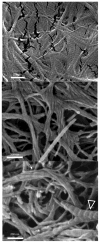Dentin on the nanoscale: Hierarchical organization, mechanical behavior and bioinspired engineering
- PMID: 28416222
- PMCID: PMC5481168
- DOI: 10.1016/j.dental.2017.03.008
Dentin on the nanoscale: Hierarchical organization, mechanical behavior and bioinspired engineering
Abstract
Objective: Knowledge of the structural organization and mechanical properties of dentin has expanded considerably during the past two decades, especially on a nanometer scale. In this paper, we review the recent literature on the nanostructural and nanomechanical properties of dentin, with special emphasis in its hierarchical organization.
Methods: We give particular attention to the recent literature concerning the structural and mechanical influence of collagen intrafibrillar and extrafibrillar mineral in healthy and remineralized tissues. The multilevel hierarchical structure of collagen, and the participation of non-collagenous proteins and proteoglycans in healthy and diseased dentin are also discussed. Furthermore, we provide a forward-looking perspective of emerging topics in biomaterials sciences, such as bioinspired materials design and fabrication, 3D bioprinting and microfabrication, and briefly discuss recent developments on the emerging field of organs-on-a-chip.
Results: The existing literature suggests that both the inorganic and organic nanostructural components of the dentin matrix play a critical role in various mechanisms that influence tissue properties.
Significance: An in-depth understanding of such nanostructural and nanomechanical mechanisms can have a direct impact in our ability to evaluate and predict the efficacy of dental materials. This knowledge will pave the way for the development of improved dental materials and treatment strategies.
Conclusions: Development of future dental materials should take into consideration the intricate hierarchical organization of dentin, and pay particular attention to their complex interaction with the dentin matrix on a nanometer scale.
Keywords: Collagen; Dentin; Intrafibrillar mineral; Organs-on-a-chip; Proteoglycans; Remineralization.
Copyright © 2017 The Academy of Dental Materials. Published by Elsevier Ltd. All rights reserved.
Figures






Similar articles
-
Removal of dentin non-collagenous structures results in the unraveling of microfibril bundles in collagen type I.Connect Tissue Res. 2017 Sep;58(5):414-423. doi: 10.1080/03008207.2016.1235566. Epub 2016 Sep 22. Connect Tissue Res. 2017. PMID: 27657550 Free PMC article.
-
Hierarchical structure and mechanical properties of remineralized dentin.J Mech Behav Biomed Mater. 2014 Dec;40:297-306. doi: 10.1016/j.jmbbm.2014.08.024. Epub 2014 Sep 16. J Mech Behav Biomed Mater. 2014. PMID: 25259668
-
Extrafibrillar collagen demineralization-based chelate-and-rinse technique bridges the gap between wet and dry dentin bonding.Acta Biomater. 2017 Jul 15;57:435-448. doi: 10.1016/j.actbio.2017.05.017. Epub 2017 May 9. Acta Biomater. 2017. PMID: 28499631
-
The dentin organic matrix - limitations of restorative dentistry hidden on the nanometer scale.Acta Biomater. 2012 Jul;8(7):2419-33. doi: 10.1016/j.actbio.2012.02.022. Epub 2012 Mar 10. Acta Biomater. 2012. PMID: 22414619 Free PMC article. Review.
-
Biomineralization of Collagen-Based Materials for Hard Tissue Repair.Int J Mol Sci. 2021 Jan 19;22(2):944. doi: 10.3390/ijms22020944. Int J Mol Sci. 2021. PMID: 33477897 Free PMC article. Review.
Cited by
-
Preparation of collagen fibrils from mineralized tissues and evaluation by atomic force microscopy.J Mech Behav Biomed Mater. 2023 Feb;138:105624. doi: 10.1016/j.jmbbm.2022.105624. Epub 2022 Dec 16. J Mech Behav Biomed Mater. 2023. PMID: 36543081 Free PMC article.
-
Streptococcus mutans Proteases Degrade Dentinal Collagen.Dent J (Basel). 2022 Nov 28;10(12):223. doi: 10.3390/dj10120223. Dent J (Basel). 2022. PMID: 36547039 Free PMC article.
-
Bioengineered Injectable Hydrogel Based on the Dentin Extracellular Matrix and Chitosan.ACS Omega. 2025 Feb 25;10(9):9210-9223. doi: 10.1021/acsomega.4c09413. eCollection 2025 Mar 11. ACS Omega. 2025. PMID: 40092817 Free PMC article.
-
The tooth on-a-chip: a microphysiologic model system mimicking the biologic interface of the tooth with biomaterials.Lab Chip. 2020 Jan 21;20(2):405-413. doi: 10.1039/c9lc00915a. Epub 2019 Dec 19. Lab Chip. 2020. PMID: 31854401 Free PMC article.
-
The Influence of New Bioactive Materials on Pulp-Dentin Complex Regeneration in the Assessment of Cone Bone Computed Tomography (CBCT) and Computed Micro-Tomography (Micro-CT) from a Present and Future Perspective-A Systematic Review.J Clin Med. 2022 May 30;11(11):3091. doi: 10.3390/jcm11113091. J Clin Med. 2022. PMID: 35683478 Free PMC article. Review.
References
-
- St John KR. Dental clinics of North America. 2007;51(3):747–60. viii. - PubMed
-
- Chen L, Shen H, Suh BI. Am J Dent. 2013;26(4):219–27. - PubMed
-
- Wegst UG, Bai H, Saiz E, Tomsia AP, Ritchie RO. Nature materials. 2015;14(1):23–36. - PubMed
-
- Ratner BD. Journal of dental education. 2001;65(12):1340–7. - PubMed
Publication types
MeSH terms
Substances
Grants and funding
LinkOut - more resources
Full Text Sources
Other Literature Sources
Miscellaneous

